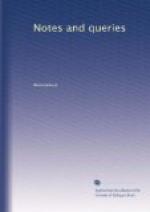C.L.L.
To eat Humble Pie.
Mr. Editor,—Your correspondent, Mr. HAMMACK, having recorded Mr. Pepys’s love of “brave venison pasty,” whilst asking the derivation of the phrase, “eating humble pie,” in reference to a bill of fare of Pepys’s age, I venture to submit that the humble pie of that period was indeed the pie named in the list quoted; and not only so, but that it was made out of the “umbles” or entrails of the deer, a dish of the second table, inferior of course to the venison pasty which smoked upon the dais, and therefore not inexpressive of that humiliation which the term “eating humble pie” now painfully describes. The “umbles” of the deer are constantly the perquisites of the gamekeeper.
A.G.
Ecclesfield, Nov. 24, 1849.
* * * * *
MINOR QUERIES.
Eva, Daughter of Dermot Mac Murrough.
Mr. Editor,—I should be glad if any of your readers, Irish or English, could inform me whether we have any other mention of Eva, daughter of Dermot Mac Murrough, last independent king of Leinster, than that she became, in the spring of the year 1170, the wife of Richard Strongbow, Earl of Pembroke, at Waterford.
Any fortunate possessor of O’Donovan’s new translation of The Annals of the Four Masters, would much oblige me by referring to the dates 1135 and 1169, and also to the period included between them, for any casual notice of the birth of this Eva, or mention of other slight incident with which she is connected, which may there exist.
A. HAPLESS HUNTER
Malvern Wells, Nov. 20, 1849.
John de Daundelyon.
Sir,—In the north chancel of St. John’s Church, Margate, is a fine brass for John Daundelyon, 1445, with a large dog at his feet; referring to which the Rev. John Lewis, in his History of the Isle of Tenet, 1723 (p. 98.), says:
“The two last bells were cast by the same founder, and the tenor the gift of one of the family of Daundelyon, which has been extinct since 1460. Concerning this bell the inhabitants repeat this traditionary rhyme:
“John de
Daundelyon, with his great dog,
Brought over this
bell on a mill-cog.”
This legend is still given to visitors of this fine old church. Will some of your antiquarian correspondents throw some light on the obscurity?
C.
Genealogy of European Sovereigns.
Sir,—Can you or any of your correspondents tell me of one or two of the best works on the “Genealogy of European Sovereigns?” I know of one,—Anderson’s Royal Genealogies, London, 1732, folio. But that is not of as late a date as I should wish to see.
Q.X.Z.
Duke of Ashgrove.
At p. 14. of Doctor Simon Forman’s Diary (edited by Mr. Halliwell, 1849), mention is twice made of Forman being engaged as “Scholmaster to the Duke of Ashgrove’s Sonnes.” Who was the person thus alluded to?




